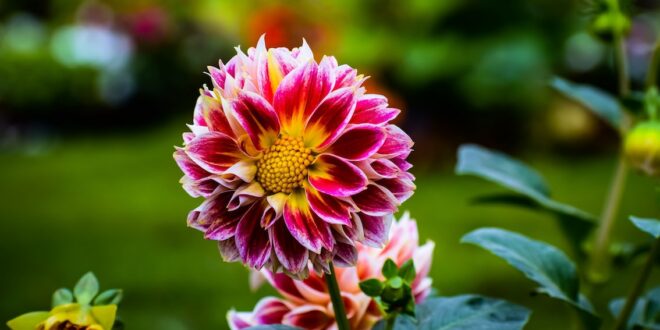Dahlias are currently enjoying a level of popularity matched by few other flowers – and they deserve to. What’s more, even ‘sophisticated’ gardeners are admitting a few into their hallowed spaces. We say ‘even’ because, for decades, dahlias have often been viewed (usually by those who know little about them) as ‘common flowers.’ It’s an attitude that likely dates all the way back to our colonial associations with the UK, and the fact dahlias were often grown, not by expert gardeners, but by working class blokes who planted them on their allotments for the sheer enjoyment of showing them in horticultural competitions.
Fast forwarding the decades, and freed from this unhelpful sort of attitude, we are now embracing dahlias for their brilliant, crazy colour, and fantastically fun forms. What’s more, these reliable flowers are proving to be every bit as sophisticated as highbrow ornamentals. In fact, alongside gypsophila, astilbe, and foxglove, white and pastel dahlias are demure enough to feature in shy cottage gardens or a bride’s bouquet.
Dahlias can be planted any time from mid-August to late December, depending on where in the country you live. So, if these eye-popping beauties have caught your eye over autumn, this is the perfect time to start planning your own dahlia garden. Here’s how:
Catalogue catch-up
Dahlias take so many different forms and habits, according to variety, it pays to sit down for an hour or two with a catalogue in order to decide exactly what sort you want in your garden. As you do, think especially about height. Taller varieties will require staking, all varieties require at least 4 hours of sun a day, and if you don’t want the blooms to be battered by winds, shelter is important. On the other hand, if you are looking only for short term container or pathway edge colour, bedding varieties may be the way to go. Bedding dahlias are treated as annuals, and can be bought inexpensively in punnets from the garden centre at the start of summer.
Garden prep
Dahlias will ‘survive’ in almost any soil (which may be another reason why ‘garden snobs’ have chosen to gloss over them). However, to bring out the best in dahlias, prepare a bed that is filled with well-rotted compost, but light on nitrogen. If you’re an organic gardener, that’s your cue to add just a scattering of aged animal manure. If you’re using garden fertilizer, check the NPK (nitrogen, phosphorous, potassium) ratio which is written on the bag. The number beside the N should be half as much as the number beside the P and the K.
Dahlias don’t like wet feet, so if you live in a spot where high rainfall is common, think about raising up your dahlia bed. This can be done by creating a box-bed (with a wood framework) or simply by mounding up the soil (this is also a great way to create a garden edging).
If you plan to grow taller varieties of dahlia, purchase some stakes, and secure them in the ground before you even think about planting. Dahlia tubers (the underground material the plants grow from) are very crisp and tender, and are easily damaged.
Planting
Dahlias are tender, so if you live in a chilly part of the country, delay planting until after frosts have abated. In frost-free regions (providing your drainage is reliable), they can go in the ground as early as late winter. Dahlia tubers are connected to a central ‘crown’ from which growth develops (click here for an excellent diagram of this from the Dahlia Society of Victoria, Australia). The tuber should be planted so the crown is just below the surface of the soil. Once planted, if it seems a later frost may arrive, cover the area with a deep mulch to protect the tender growing point.
Dahlias are far from ‘common.’ They are reliable, easy-to-grow, show-stopping or subtle (depending on form and colour) and they bring delight to the garden from mid-summer to late autumn. Whether it’s browsing a catalogue or preparing a bed, you can enjoy planning your dahlia garden today!










Join the Discussion
Type out your comment here:
You must be logged in to post a comment.